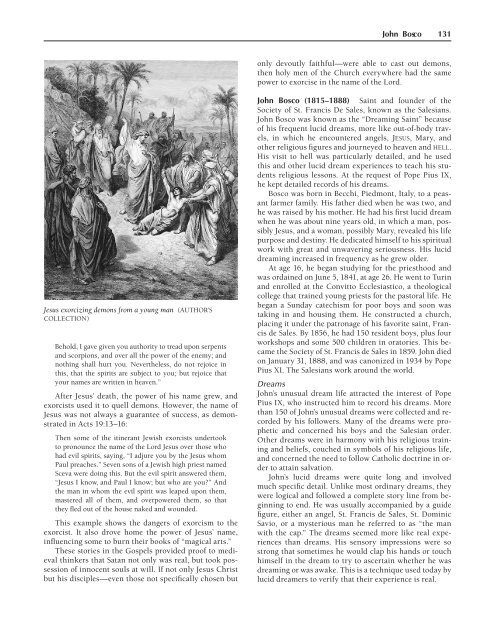The Encyclopedia Of Demons And Demonology
The Encyclopedia Of Demons And Demonology
The Encyclopedia Of Demons And Demonology
Create successful ePaper yourself
Turn your PDF publications into a flip-book with our unique Google optimized e-Paper software.
John Bosco 131<br />
only devoutly faithful—were able to cast out demons,<br />
then holy men of the Church everywhere had the same<br />
power to exorcise in the name of the Lord.<br />
Jesus exorcizing demons from a young man (AUTHOR’S<br />
COLLECTION)<br />
Behold, I gave given you authority to tread upon serpents<br />
and scorpions, and over all the power of the enemy; and<br />
nothing shall hurt you. Nevertheless, do not rejoice in<br />
this, that the spirits are subject to you; but rejoice that<br />
your names are written in heaven.”<br />
After Jesus’ death, the power of his name grew, and<br />
exorcists used it to quell demons. However, the name of<br />
Jesus was not always a guarantee of success, as demonstrated<br />
in Acts 19:13–16:<br />
<strong>The</strong>n some of the itinerant Jewish exorcists undertook<br />
to pronounce the name of the Lord Jesus over those who<br />
had evil spirits, saying, “I adjure you by the Jesus whom<br />
Paul preaches.” Seven sons of a Jewish high priest named<br />
Sceva were doing this. But the evil spirit answered them,<br />
“Jesus I know, and Paul I know; but who are you?” <strong>And</strong><br />
the man in whom the evil spirit was leaped upon them,<br />
mastered all of them, and overpowered them, so that<br />
they fled out of the house naked and wounded.<br />
This example shows the dangers of exorcism to the<br />
exorcist. It also drove home the power of Jesus’ name,<br />
influencing some to burn their books of “magical arts.”<br />
<strong>The</strong>se stories in the Gospels provided proof to medieval<br />
thinkers that Satan not only was real, but took possession<br />
of innocent souls at will. If not only Jesus Christ<br />
but his disciples—even those not specifically chosen but<br />
John Bosco (1815–1888) Saint and founder of the<br />
Society of St. Francis De Sales, known as the Salesians.<br />
John Bosco was known as the “Dreaming Saint” because<br />
of his frequent lucid dreams, more like out-of-body travels,<br />
in which he encountered angels, JESUS, Mary, and<br />
other religious figures and journeyed to heaven and HELL.<br />
His visit to hell was particularly detailed, and he used<br />
this and other lucid dream experiences to teach his students<br />
religious lessons. At the request of Pope Pius IX,<br />
he kept detailed records of his dreams.<br />
Bosco was born in Becchi, Piedmont, Italy, to a peasant<br />
farmer family. His father died when he was two, and<br />
he was raised by his mother. He had his first lucid dream<br />
when he was about nine years old, in which a man, possibly<br />
Jesus, and a woman, possibly Mary, revealed his life<br />
purpose and destiny. He dedicated himself to his spiritual<br />
work with great and unwavering seriousness. His lucid<br />
dreaming increased in frequency as he grew older.<br />
At age 16, he began studying for the priesthood and<br />
was ordained on June 5, 1841, at age 26. He went to Turin<br />
and enrolled at the Convitto Ecclesiastico, a theological<br />
college that trained young priests for the pastoral life. He<br />
began a Sunday catechism for poor boys and soon was<br />
taking in and housing them. He constructed a church,<br />
placing it under the patronage of his favorite saint, Francis<br />
de Sales. By 1856, he had 150 resident boys, plus four<br />
workshops and some 500 children in oratories. This became<br />
the Society of St. Francis de Sales in 1859. John died<br />
on January 31, 1888, and was canonized in 1934 by Pope<br />
Pius XI. <strong>The</strong> Salesians work around the world.<br />
Dreams<br />
John’s unusual dream life attracted the interest of Pope<br />
Pius IX, who instructed him to record his dreams. More<br />
than 150 of John’s unusual dreams were collected and recorded<br />
by his followers. Many of the dreams were prophetic<br />
and concerned his boys and the Salesian order.<br />
Other dreams were in harmony with his religious training<br />
and beliefs, couched in symbols of his religious life,<br />
and concerned the need to follow Catholic doctrine in order<br />
to attain salvation.<br />
John’s lucid dreams were quite long and involved<br />
much specific detail. Unlike most ordinary dreams, they<br />
were logical and followed a complete story line from beginning<br />
to end. He was usually accompanied by a guide<br />
figure, either an angel, St. Francis de Sales, St. Dominic<br />
Savio, or a mysterious man he referred to as “the man<br />
with the cap.” <strong>The</strong> dreams seemed more like real experiences<br />
than dreams. His sensory impressions were so<br />
strong that sometimes he would clap his hands or touch<br />
himself in the dream to try to ascertain whether he was<br />
dreaming or was awake. This is a technique used today by<br />
lucid dreamers to verify that their experience is real.












